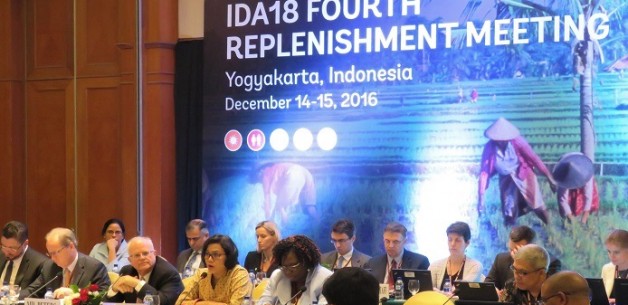After several months of negotiations, and the announcement of a record $75 billion replenishment for the World Bank’s fund for the poorest countries, the final IDA18 replenishment report was publicly released in late January, 2017. The agreement to fund the World Bank’s soft-loan window comes at an uncertain time for development aid in the United States, with President Trump proposing to slash foreign aid assistance, and completely cut foreign climate change programs. Nevertheless, the IDA18 agreement is an ambitious proposal that is an important step forward for the Bank in how it addresses climate change and its drivers, citizen engagement, gender-based violence (GBV) and other areas that are critical for the Bank to achieve its goals.
IDA18 reflects some of the most significant changes in development policy that have occurred over the past three years since the last replenishment agreement was reached–both internationally and within the World Bank itself–namely, the Paris agreement and the Sustainable Development Goals (SDGs), as well as the Bank’s own development of its Climate Change Action Plan (CCAP) and Forest Action Plan (FAP). It also represents an effort to incorporate lessons learned from failures over the last three years including the disastrous Uganda Transport Sector Development Project that led to the creation of the Bank’s Global Task Force on Gender-Based Violence.
With respect to forests and land use, IDA18 represents a step forward from IDA17’s more superficial treatment of the challenges and opportunities posed by climate change by drilling down to how IDA is uniquely placed to help borrowers meet their individual climate goals–specifically those identified in the Nationally Determined Contributions (NDCs) which connect national policies to the global framework of the Paris agreement. Importantly, IDA18 references the fact that virtually all forested IDA countries saw reducing deforestation and improving forest management as a means of reaching their goals. The agreement commits to translating NDCs into specific policies and investment plans in 10 IDA countries, and to developing 10 climate smart agriculture plans and 10 forest policy notes–twice as many as proposed in the initial proposals after extensive advocacy by BIC and others.
There was little mention of climate change reduction strategies in IDA17 beyond a few references to renewable energy. In IDA18 on the other hand, climate change is is said to need a “transformational paradigm shift” and can no longer be thought of as just another “development priority”. Instead the report states that it needs to be tackled in an “integrated matter” with all development activities including those focused on gender and governance.
IDA18 also made a small but important change to an indicator on deforestation in the results measurement system (RMS)–a list of indicators that IDA will monitor and report on over the next three years to measure its progress toward achieving the goals laid out in the report. In a welcome change from the IDA17 RMS, the IDA18 report scrapped a vague indicator on deforestation that relied on data which is only updated every three years, and subject to political coercion, replacing it with an indicator that measures “average annual deforestation change”, citing data reported from the WDI which is updated annually from an unbiased source. This significant change will result in more accurate deforestation reporting during the IDA18 period, which is an important first step to understanding how deforestation can be reduced in the future.
The IDA18 report also includes important commitments related to citizen engagement and gender-based violence, which will undoubtedly provide civil society with important platforms to discuss the World Bank’s progress in designing and implementing projects that ensure all who may be impacted by development–in particular those who are disadvantaged or marginalized–are considered and included in the process. BIC also welcomed the unprecedented transparency of the IDA18 negotiations and the various opportunities for civil society to engage in the process over the course of several months leading up to the release of the final report. We look forward to continuing this dialogue as the IDA18 commitments are monitored over the next three years.
For more information on IDA and the replenishment process, see BIC’s page on IDA here.
See BIC’s detailed comments on the draft IDA18 report here.

